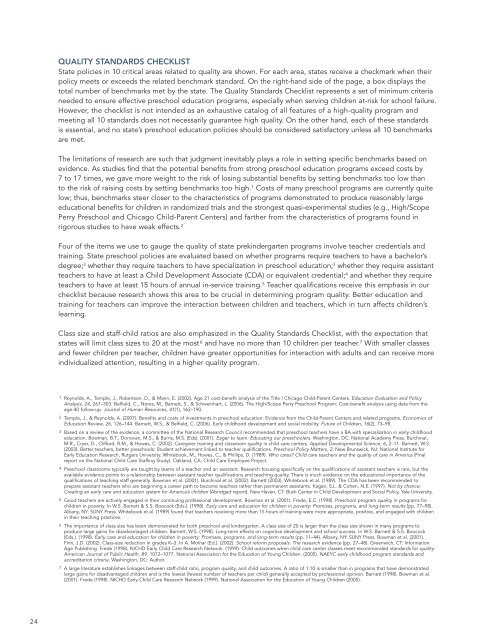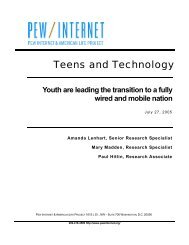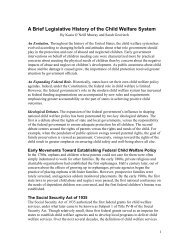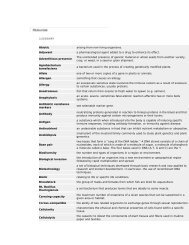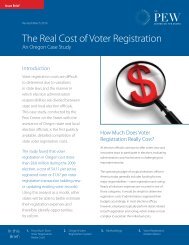Report: The State of Preschool 2008: State Preschool Yearbook
Report: The State of Preschool 2008: State Preschool Yearbook
Report: The State of Preschool 2008: State Preschool Yearbook
You also want an ePaper? Increase the reach of your titles
YUMPU automatically turns print PDFs into web optimized ePapers that Google loves.
QUALITY STANDARDS CHECKLIST<br />
<strong>State</strong> policies in 10 critical areas related to quality are shown. For each area, states receive a checkmark when their<br />
policy meets or exceeds the related benchmark standard. On the right-hand side <strong>of</strong> the page, a box displays the<br />
total number <strong>of</strong> benchmarks met by the state. <strong>The</strong> Quality Standards Checklist represents a set <strong>of</strong> minimum criteria<br />
needed to ensure effective preschool education programs, especially when serving children at-risk for school failure.<br />
However, the checklist is not intended as an exhaustive catalog <strong>of</strong> all features <strong>of</strong> a high-quality program and<br />
meeting all 10 standards does not necessarily guarantee high quality. On the other hand, each <strong>of</strong> these standards<br />
is essential, and no state’s preschool education policies should be considered satisfactory unless all 10 benchmarks<br />
are met.<br />
<strong>The</strong> limitations <strong>of</strong> research are such that judgment inevitably plays a role in setting specific benchmarks based on<br />
evidence. As studies find that the potential benefits from strong preschool education programs exceed costs by<br />
7 to 17 times, we gave more weight to the risk <strong>of</strong> losing substantial benefits by setting benchmarks too low than<br />
to the risk <strong>of</strong> raising costs by setting benchmarks too high. 1 Costs <strong>of</strong> many preschool programs are currently quite<br />
low; thus, benchmarks steer closer to the characteristics <strong>of</strong> programs demonstrated to produce reasonably large<br />
educational benefits for children in randomized trials and the strongest quasi-experimental studies (e.g., High/Scope<br />
Perry <strong>Preschool</strong> and Chicago Child-Parent Centers) and farther from the characteristics <strong>of</strong> programs found in<br />
rigorous studies to have weak effects. 2<br />
Four <strong>of</strong> the items we use to gauge the quality <strong>of</strong> state prekindergarten programs involve teacher credentials and<br />
training. <strong>State</strong> preschool policies are evaluated based on whether programs require teachers to have a bachelor’s<br />
degree; 3 whether they require teachers to have specialization in preschool education; 3 whether they require assistant<br />
teachers to have at least a Child Development Associate (CDA) or equivalent credential; 4 and whether they require<br />
teachers to have at least 15 hours <strong>of</strong> annual in-service training. 5 Teacher qualifications receive this emphasis in our<br />
checklist because research shows this area to be crucial in determining program quality. Better education and<br />
training for teachers can improve the interaction between children and teachers, which in turn affects children’s<br />
learning.<br />
Class size and staff-child ratios are also emphasized in the Quality Standards Checklist, with the expectation that<br />
states will limit class sizes to 20 at the most 6 and have no more than 10 children per teacher. 7 With smaller classes<br />
and fewer children per teacher, children have greater opportunities for interaction with adults and can receive more<br />
individualized attention, resulting in a higher quality program.<br />
1 Reynolds, A., Temple, J., Robertson, D., & Mann, E. (2002). Age 21 cost-benefit analysis <strong>of</strong> the Title I Chicago Child-Parent Centers. Education Evaluation and Policy<br />
Analysis, 24, 267–303. Belfield, C., Nores, M., Barnett, S., & Schweinhart, L. (2006). <strong>The</strong> High/Scope Perry <strong>Preschool</strong> Program: Cost-benefit analysis using data from the<br />
age-40 follow-up. Journal <strong>of</strong> Human Resources, 41(1), 162–190.<br />
2 Temple, J., & Reynolds, A. (2007). Benefits and costs <strong>of</strong> investments in preschool education: Evidence from the Child-Parent Centers and related programs. Economics <strong>of</strong><br />
Education Review, 26, 126–144. Barnett, W.S., & Belfield, C. (2006). Early childhood development and social mobility. Future <strong>of</strong> Children, 16(2), 73–98.<br />
3 Based on a review <strong>of</strong> the evidence, a committee <strong>of</strong> the National Research Council recommended that preschool teachers have a BA with specialization in early childhood<br />
education. Bowman, B.T., Donovan, M.S., & Burns, M.S. (Eds). (2001). Eager to learn: Educating our preschoolers. Washington, DC: National Academy Press. Burchinal,<br />
M.R., Cryer, D., Clifford, R.M., & Howes, C. (2002). Caregiver training and classroom quality in child care centers. Applied Developmental Science, 6, 2–11. Barnett, W.S.<br />
(2003). Better teachers, better preschools: Student achievement linked to teacher qualifications. <strong>Preschool</strong> Policy Matters, 2. New Brunswick, NJ: National Institute for<br />
Early Education Research, Rutgers University. Whitebook, M., Howes, C., & Phillips, D. (1989). Who cares? Child care teachers and the quality <strong>of</strong> care in America (Final<br />
report on the National Child Care Staffing Study). Oakland, CA: Child Care Employee Project.<br />
4 <strong>Preschool</strong> classrooms typically are taught by teams <strong>of</strong> a teacher and an assistant. Research focusing specifically on the qualifications <strong>of</strong> assistant teachers is rare, but the<br />
available evidence points to a relationship between assistant teacher qualifications and teaching quality. <strong>The</strong>re is much evidence on the educational importance <strong>of</strong> the<br />
qualifications <strong>of</strong> teaching staff generally. Bowman et al. (2001). Burchinal et al. (2002). Barnett (2003). Whitebook et al. (1989). <strong>The</strong> CDA has been recommended to<br />
prepare assistant teachers who are beginning a career path to become teachers rather than permanent assistants. Kagan, S.L. & Cohen, N.E. (1997). Not by chance:<br />
Creating an early care and education system for America’s children [Abridged report]. New Haven, CT: Bush Center in Child Development and Social Policy, Yale University.<br />
5 Good teachers are actively engaged in their continuing pr<strong>of</strong>essional development. Bowman et al. (2001). Frede, E.C. (1998). <strong>Preschool</strong> program quality in programs for<br />
children in poverty. In W.S. Barnett & S.S. Boocock (Eds.). (1998). Early care and education for children in poverty: Promises, programs, and long-term results (pp. 77–98).<br />
Albany, NY: SUNY Press. Whitebook et al. (1989) found that teachers receiving more than 15 hours <strong>of</strong> training were more appropriate, positive, and engaged with children<br />
in their teaching practices.<br />
6 <strong>The</strong> importance <strong>of</strong> class size has been demonstrated for both preschool and kindergarten. A class size <strong>of</strong> 20 is larger than the class size shown in many programs to<br />
produce large gains for disadvantaged children. Barnett, W.S. (1998). Long-term effects on cognitive development and school success. In W.S. Barnett & S.S. Boocock<br />
(Eds.). (1998). Early care and education for children in poverty: Promises, programs, and long-term results (pp. 11–44). Albany, NY: SUNY Press. Bowman et al. (2001).<br />
Finn, J.D. (2002). Class-size reduction in grades K–3. In A. Molnar (Ed.). (2002). School reform proposals: <strong>The</strong> research evidence (pp. 27–48). Greenwich, CT: Information<br />
Age Publishing. Frede (1998). NICHD Early Child Care Research Network. (1999). Child outcomes when child care center classes meet recommended standards for quality.<br />
American Journal <strong>of</strong> Public Health, 89, 1072–1077. National Association for the Education <strong>of</strong> Young Children. (2005). NAEYC early childhood program standards and<br />
accreditation criteria. Washington, DC: Author.<br />
7 A large literature establishes linkages between staff-child ratio, program quality, and child outcomes. A ratio <strong>of</strong> 1:10 is smaller than in programs that have demonstrated<br />
large gains for disadvantaged children and is the lowest (fewest number <strong>of</strong> teachers per child) generally accepted by pr<strong>of</strong>essional opinion. Barnett (1998). Bowman et al.<br />
(2001). Frede (1998). NICHD Early Child Care Research Network (1999). National Association for the Education <strong>of</strong> Young Children (2005).<br />
24


